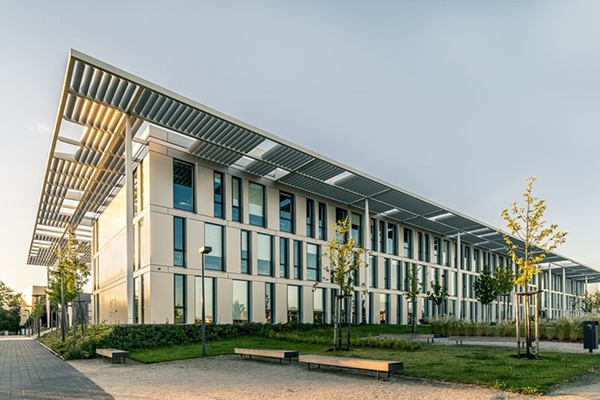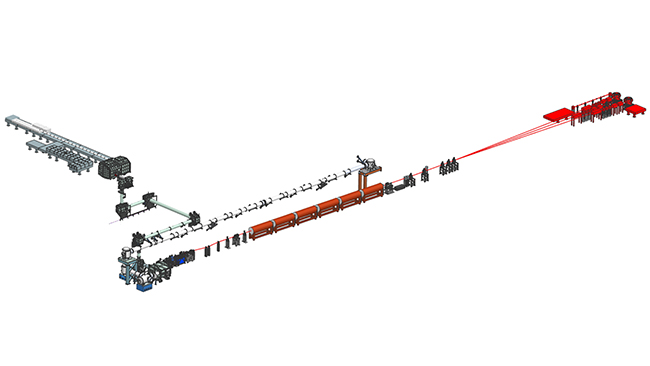EuPRAXIA selects ELI for second Laser-Driven Accelerator Site

The University of Liverpool, through its QUASAR Group, plays a pivotal role in the EuPRAXIA project. Since its foundation in 2015, Prof Carsten Welsch and his group have supported the project through cutting-edge research in advanced beam diagnostics and have led dissemination and public relations efforts to build a favourable foundation for EuPRAXIA’s implementation and operation.
The EuPRAXIA project aims to build a compact, high-performance electron accelerator infrastructure using advanced laser and beam-driven plasma wakefield acceleration technology.
EuPRAXIA, included in the 2021 Roadmap of the European Strategy Forum on Research Infrastructures (ESFRI), will be implemented across two sites. The first focusses on particle-driven wakefield acceleration and is currently being developed at Frascati National Laboratory (INFN), Italy. The second site will use laser-driven wakefield acceleration. After an extensive evaluation process, a decision on the location of the second site has now been made.
ELI, specifically the ELI Beamlines Facility in Dolní Břežany, Czech Republic, has been selected by the EuPRAXIA Consortium as the site for its laser-driven plasma accelerator pillar. The decision follows an evaluation process involving expert assessments on infrastructure readiness, technical capabilities, and strategic alignment with EuPRAXIA’s long-term objectives. The two sites, ELI Beamlines and INFN will form a pan-European distributed research infrastructure dedicated to transformative research and innovation in accelerator science.
“This decision adopted by the EuPRAXIA Consortium is a great achievement,” says Dr. Pierluigi Campana, EuPRAXIA’s Coordinator. “The choice of the second site is one of the most relevant milestones of the EuPRAXIA Preparatory Phase and a crucial step toward the implementation.”

Proposed set up of the EuPRAXIA Laser-Plasma-Accelerator-based 1-GeV Free-Electron Laser (FEL) at ELI Beamlines, driven by the L2 laser. (Photo credit: ELI ERIC)
ELI Beamlines was selected for its infrastructure readiness, state-of-the-art laser systems, and comprehensive technical expertise. Leveraging existing infrastructure to reduce the need for further investments, ensuring a cost-effective deployment is ELI’s effective integration strategy. With it’s advanced high-power, high-repetition-rate laser systems, including the newly developed L2 DUHA laser, and versatile experimental setups, ELI is ideally equipped to implement and operate the Laser-Plasma-Accelerator-based 1-GeV Free-Electron Laser (FEL) envisioned by EuPRAXIA.
“We are proud and honoured by EuPRAXIA's decision to place its second site at ELI after such a thorough and transparent evaluation process. Being selected by EuPRAXIA is not just recognition—it’s a responsibility we embrace enthusiastically,” says Allen Weeks, ELI ERIC Director General. “We look forward to collaborating closely with the entire EuPRAXIA consortium and our partners to advance accelerator science and generate substantial benefits for science, industry, and society.”
Hosting the EuPRAXIA site at ELI unlocks substantial scientific, technological, and economic benefits, strengthening Europe’s competitiveness in laser-plasma research in the broader Central European region.
EuPRAXIA also recognises the important roles of the other candidates for the second site, The National Institute of Optics (CNR-INO), Italy and Extreme Photonics Applications Centre (EPAC) in the UK and welcomes their joint engagement in supporting the successful implementation of the second site.
CNR-INO could function as EuPRAXIA's National Node in Italy, leading laser-plasma acceleration research and acting as a critical link between the two EuPRAXIA sites established in Italy and the Czech Republic, ensuring strong cohesion and scientific exchange within the consortium.
EPAC could contribute to EuPRAXIA as a centre for R&D, focusing on advancing research towards achieving a high-quality 5 GeV electron beam from compact laser-plasma accelerators suitable for FEL applications. Having such a site in the UK will further strengthen its position in accelerator science.
In addition, the UK has several internationally leading groups working on wakefield acceleration and applications, both laser-driven (LWFA) and beam-driven (PWFA). All of these groups collaborate
closely with the leading groups across Europe. Many of the UK groups are university based, and several are affiliated with one of the two national accelerator institutes (the Cockcroft Institute and the John Adams Institute). As highlighted in the EuPRAXIA Conceptional Design Report (CDR), the long-standing track record in laser- and beam-driven electron acceleration and in the generation and application of secondary sources and experience of international collaboration mean that the UK is ideally placed to host the planned EuPRAXIA Excellence Centre for Advanced Application Beamlines, with Daresbury Laboratory being at the heart of the joint effort
The upcoming steps involve collaborative efforts among EuPRAXIA members to prepare a Technical Design Report (TDR) that outlines the relevant technologies and stages of implementation—from initial setup to full-scale operations. The TDR will serve as a foundation for the realisation of the second site, with operations expected to begin in 2031. The first phase will focus on establishing the core infrastructure and commissioning the soft X-ray free-electron laser (FEL) based on laser-plasma acceleration (LPA) at 1 GeV. Phase 2 will culminate in the consolidation of resources between EuPRAXIA and ELI, significantly expanding the facility’s capabilities through the addition of a novel 5-GeV free-electron laser (FEL). This will position EuPRAXIA at ELI as a key hub for cutting-edge research based on laser-plasma acceleration (LPA).
As the only large-scale laser facility of its kind in Central and Eastern Europe, ELI plays a critical role in bridging regional scientific excellence with pan-European innovation agendas. It’s selection as the second site represents a significant step forward for EuPRAXIA, reinforcing Europe's leadership in advanced accelerator technologies and demonstrating the immense potential of collaborative, innovative science.